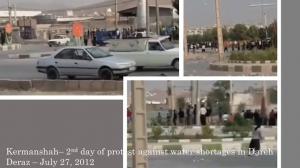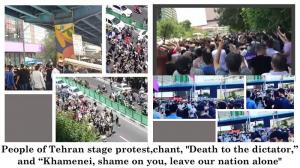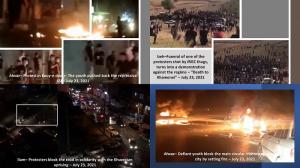
(Video) Iran: Khuzestan Water Shortage Protests Continually Expand Geographic Reach and Messaging

(PMOI / MEK Iran) and (NCRI): Protests in Tehran Pars, Karaj (Gohardasht), Isfahan (Baharestan), Kermanshah, and Eyvan. Protesters chant: “Death to Khamenei, Death to the dictators, No to Gaza, No to Lebanon, I sacrifice my life for Iran”.
Participants in the past two weeks’ protests have decried this involvement with the familiar slogan, “Neither Gaza nor Lebanon; I give my life only for Iran.”
PARIS, FRANCE, July 29, 2021 /EINPresswire.com/ -- As summer temperatures soared in the Iranian province of Khuzestan, water shortages became a pronounced crisis, sparking mass protests in a number of cities and towns including Ahvaz, Khorramshahr, Hamidiyeh, and Mahshahr. The first such demonstrations were recorded on July 15, and these helped to establish the messaging that would define the protests for two weeks and counting.
Many participants in the first night’s protests chanted, “We will not accept humiliation.” Over time, that slogan has been adapted to reflect the government’s violent response, so that many current participants are chanting, “Iranians die, but we will not accept humiliation.” The first known fatality from the unrest took place on the second day, July 16, and the victim was identified as 26-year-old Mostafa Na’imawi.
Since then, at least eleven other protesters have been killed, apparently all of them in shooting incidents carried out by State Security Forces or the Islamic Revolutionary Guard Corps. The Basij civilian militia has also been dispatched to help crackdown on unrest, in keeping with the multi-pronged approach that the regime typically takes toward the repression of dissent. Within the first twelve days of protests, the IRGC personally arrested at least one hundred individuals, and regular law enforcement may have swept up thousands during that same time, including known and suspected activists as well as direct participants in the unrest.
All of these arrests and killings, however, seem to have had the opposite of the intended effect, driving more Iranians into the streets to explicitly demonstrate solidarity with the residents of Khuzestan instead of driving those residents back into their homes. The solidarity demonstrations were encouraged from the second day of the protests onward, by statements from the National Council of Resistance of Iran and its President-elect Mrs. Maryam Rajavi.
The first such statement called upon “all youths” to rush to the aid of activists in Khuzestan, “especially those wounded.” This appeal to youth seemingly reflects the preexisting demographics of the protest movement, as young and often highly-educated Iranians press not just for a redress of grievances but also for a wholesale change of government in the wake of the regime’s massive contributions to crises including but not limited to the Khuzestan water shortage.
The youthful demographics of the protest movement are also reflected in early reports of casualties from the regime’s crackdown. On Sunday, the People’s Mojahedin Organization of Iran (PMOI/MEK), released the names of twelve known victims of that crackdown, along with their places of residence and the locations of their deaths. Of the seven whose ages were known, all were under the age of 30 and two were only 17 years old.
One of those teenage victims, Hadi Bahmani, was given a funeral on Friday, three days after his death, and supporters used the occasion to stage another demonstration with a greater focus on the regime’s political violence and general disregard for the welfare of the Iranian people, rather than the water shortages themselves. Both categories of the demonstration have seen their slogans transition from addressing specific issues to calling for the ouster of the regime that is responsible for them.
Among some of the latest protests within Khuzestan, protesters were heard to highlight the province’s vast oil and gas resources and to ask what has happened to them and the wealth generated from them. In call-and-response chants, some protesters posed this question only to answer that the resources in question had been squandered in the regime’s terrorist activities in the region and in Gaza and Lebanon. This sentiment has proven commonplace among Iranian activists in recent years, as economic conditions have worsened for the vast majority of the population even as costly Iranian involvement in regional conflicts has expanded.
Participants in the past two weeks’ protests have decried this involvement with the familiar slogan, “Neither Gaza nor Lebanon; I give my life only for Iran.” This has been a common feature of protests spanning the past several years, including nationwide uprisings in January 2018 and November 2019. Both uprisings gave an outlet to explicit calls for regime change, which have also been repeated in the context of the Khuzestan water shortages.
The surrounding solidarity demonstrations have notably included outright declarations like, “We do not want the regime.” Meanwhile, the movement’s revolutionary prospects have grown in the form of strategic organization, with participants on Sunday burning tires and erecting barricades in order to block transit routes used by regime authorities in at least 12 different cities.
Since July 15 and the calls to action by the NCRI, related demonstrations have been recorded in Tabriz, Saqqez, Zanjan, Mahashahr, Lorestan, Bushehr, and Isfahan, in spite of the fact that internet outages are making it difficult both to report such demonstrations and to coordinate them. Nonetheless, that coordination has become a noticeable feature of some of the latest calls to action inside Iran, as evidenced by the repetition of slogans like, “From Karaj to Khuzestan, let us all unite,” and “Do not be afraid; we are all together.”
Just days before the outbreak of the water-shortage protests, the NCRI held the Free Iran World Summit, featuring multiple speeches from Mrs. Rajavi and dozens of political supporters from the United States, the European Union, and elsewhere. In one of her speeches, Mrs. Rajavi predicted that the “new era” following the August 5 inauguration of Ebrahim Raisi would be defined by a historic uptick in the conflict between the Iranian regime and civil society. The protests in and around Khuzestan are arguably a preview of this phenomenon and an expression of the people’s expectation that Raisi will not meaningfully address water shortages or other well-recognized crises.
Raisi was a major participant in the 1988 massacre that killed over 30,000 political prisoners, most of them members of the People’s Mojahedin, MEK. In 2019, several months after being appointed judiciary chief, he oversaw the crackdown on the nationwide uprising in November of that year, which killed approximately 1,500 people in a matter of days. In recognition of this legacy, the vast majority of Iran’s eligible voters boycotted Raisi’s effectively uncontested election and arguably signaled their intention to resist his rule for as long as it lasts.
This sentiment was also repeated against the backdrop of the water-shortage protests. On Monday, young activists in the city of Karaj declared that “unless we obtain our rights, these protests will continue every night.” In the same demonstration, State Security Forces attempted to carry out an arrest but were repelled by massive crowds. Meanwhile, the implications of such clashes were expressed in multiple protest regions, with participants boasting that “neither guns nor tanks” will prevent the Iranian people from continuing to protest for their rights and perhaps ultimately for a wholesale change of government.
Shahin Gobadi
NCRI
+33 6 50 11 98 48
email us here
Visit us on social media:
Facebook
Twitter
Iran: protesters in Karaj join demonstrations in Khuzestan, 12-day protests demand regime change
Distribution channels: Human Rights, International Organizations, Politics, U.S. Politics, World & Regional
Legal Disclaimer:
EIN Presswire provides this news content "as is" without warranty of any kind. We do not accept any responsibility or liability for the accuracy, content, images, videos, licenses, completeness, legality, or reliability of the information contained in this article. If you have any complaints or copyright issues related to this article, kindly contact the author above.
Submit your press release






